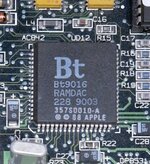Can I ask how come you say 15bit? Isn't it 16bit? I always understood it was 65,536 colours? 2^16?
It is for everybody else, but Apple defined 'thousands' as 32768 colours (2^15), with exactly 5 bits per channel. Everybody else uses the 16th bit as an extra 6th bit for the green (?) channel, but for Apple it is unused. See "
Imaging With QuickDraw", p1-20, "Direct Colors". The translation scheme between depth is in section "Color QuickDraw’s Translation of RGB Colors to Pixel Values" p4-13.
It is normally stored as a 16-bit value in memory. Same as in post-80s systems, 24-bits (8 per channels) is commonly stored as a 32-bits value, with the extra 8 bits either unused or used for e.g. alpha channel. In the eighties, it would have been more common to use 'true' 24-bits storage, usually using 3 banks of 8-bits memory. They would be either concatenated in a single 24-bits value for 'chunky' representation, or used as three 8-bits plane for 'planar' representation.



